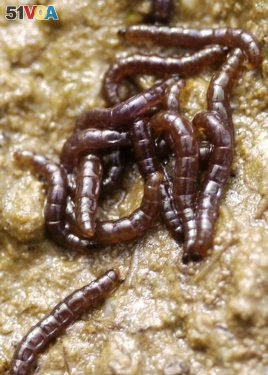August 12,2014
Scientists have just sequenced the genome of a fly native to Antarctica, the coldest, driest and windiest place on the planet, a finding that may lead to a wider understanding of how these bugs evolved to cope with the environment.
The fly, named Belgica antarctica, is a survivor, or as Washington State University evolutionary biologist Joanna Kelley likes to put it…an extremophile.
“This fly has to withstand freezing, extreme temperature changes so in the Antarctic summer it’s on the rocks and those are getting quite hot," Kelley said. "But imagine the Antarctic winter, it’s very dark and cold. There’s a lot of UV [ultraviolet] radiation. There’s dehydration. And anything you can imagine as an extreme pressure, this fly probably encounters it.”
Common fly
The fly is a midge, a group of small flies found practically everywhere on earth.
This midge has evolved to survive in the extreme environment of the rocky outcrops of the Antarctic Peninsula.

Larvae of the midge Belgica antarctica (Credit: Richard E. Lee, Jr.)
It is wingless, so it can't be swept up by the wind and blown into the sea. It can also tolerate 40 percent or more water loss in its cells, more than double that of other midges.
Kelley says the fly spends two years as larvae over two cold seasons.
“They look like dried up little raisins and that’s how they survive the winter," she said. "They are not developmentally active during that time, but they are still alive. This begs the question of, 'Does the small genome somehow enable them to go through that process, or the growing process in the summer more rapidly, or facilitate that somehow?'”
Smallest bug sequenced
Belgica antarctica is the first polar insect and the first freeze-tolerant insect whose genome - or genetic material - has been sequenced.
It is also the smallest bug sequenced to date. Its genome has 99 million base pairs, the DNA building blocks of an organism. That's tiny compared with the human genome which has 3.2 billion base pairs.
Kelley says the genome gives researchers a framework to study the organism in much more depth. For example, she says, they can look for what triggers its genes to activate a protein in response to heat or cold stress.

Wingless adult male of the midge Belgica antarctica (Credit: Richard E. Lee, Jr.)
“The heat shock proteins are important in this fly, particularly because they are expressed all the time," she said. "In other organisms, heat shock proteins, which are turned on in response to temperature or other stresses, in the fly they are turned on all the time. And this process may give us insight into how the fly is able to survive over the winter.”
Possible medical advances
Kelley says understanding how the freeze tolerant mechanism works in a bug could lead to developments outside the insect world.
The most direct human application, she says, might be in cryo-preservation or the freezing of human cells or tissues for medical purposes.
The study is published in the journal Nature Communications.